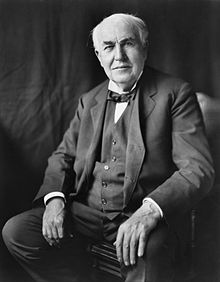 Thomas Alva Edison (February 11, 1847 – October 18, 1931) was an American inventor and businessman who has been described as America's greatest inventor. He developed many devices in fields such as electric power generation, mass communication, sound recording, and motion pictures.These inventions, which include the phonograph, the motion picture camera, and the long-lasting, practical electric light bulb, have had a widespread impact on the modern industrialized world.He was one of the first inventors to apply the principles of organized science and teamwork to the process of invention, working with many researchers and employees. He established the first industrial research laboratory.
Edison was raised in the American Midwest; early in his career he worked as a telegraph operator, which inspired some of his earliest inventions. In 1876, he established his first laboratory facility in Menlo Park, New Jersey, where many of his early inventions were developed. He later established a botanic laboratory in Fort Myers, Florida in collaboration with businessmen Henry Ford and Harvey Firestone, and a laboratory in West Orange,New Jersey that featured the world's first film studio, the Black Maria. He was a prolific inventor, holding 1,093 US patents in his name, as well as patents in other countries. Edison married twice and fathered six children. He died in 1931 of complications of diabetes.
Edison's family moved to Port Huron, Michigan after the canal owners successfully kept the railroad out of Milan, Ohio in 1854 and business declined. Edison sold candy and newspapers on trains running from Port Huron to Detroit, and sold vegetables. Although he frustrated teachers and went in and out of various schools in Ohio and Michigan, he read steadily and voraciously under his mother's supervision. He turned a $50 a week profit by age 13, most of which went to buying equipment for electric and chemical experiments. He became a telegraph operator after he saved three-year-old Jimmie MacKenzie from being struck by a runaway train.
Jimmie'sJimmie's father, station agent J. U. MacKenzie of Mount Clemens, Michigan, was so grateful that he trained Edison as a telegraph operator. Edison's first telegraphy job away from Port Huron was at Stratford Junction, Ontario, on the Grand Trunk Railway. He was held responsible for a near collision. He also studied qualitative analysis and conducted chemical experiments on the train until he left the job. Edison obtained the exclusive right to sell newspapers on the road, and, with the aid of four assistants, he set in type and printed the Grand Trunk Herald, which he sold with his other papers. This began Edison's long streak of entrepreneurial ventures, as he discovered his talents as a businessman. These talents eventually led him to found 14 companies, including General Electric, still one of the largest publicly traded companies in the world. In 1866, at the age of 19, Edison moved to Louisville, Kentucky, where, as an employee of Western Union, he worked the Associated Press bureau news wire. Edison requested the night shift, which allowed him plenty of time to spend at his two favorite pastimes—reading and experimenting. Eventually, the latter pre-occupation cost him his job. One night in 1867, he was working with a lead-acid battery when he spilled sulfuric acid onto the floor. It ran between the floorboards and onto his boss's desk below. The next morning Edison was fired. His first patent was for the electric vote recorder, U.S. Patent 90,646, which was granted on June 1, 1869. Finding little demand for the machine, Edison moved to New York City shortly thereafter. One of his mentors during those early years was a fellow telegrapher and inventor named Franklin Leonard Pope, who allowed the impoverished youth to live and work in the basement of his Elizabeth, New Jersey, home, while Edison worked for Samuel Laws at the Gold Indicator Company. Pope and Edison founded their own company in October 1869, working as electrical engineers and inventors. Edison began developing a multiplex telegraphic system, which could send two messages simultaneously, in 1874. |

Comments
Post a Comment